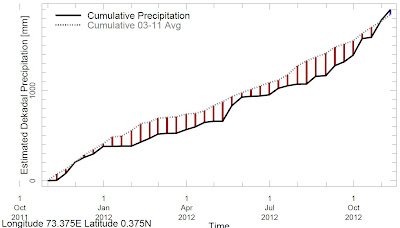Highlights
Rainfall in Southern Maldives was higher than usual and as a result the cumulative rainfall over the last 365 days was as expected from the 2003-2011 averages. The 365 day cumulative rainfall for both Central and Northern Maldives is below expected- the drought persists although rainfall was about average during the last two months as expected during an El Nino. El Nino conditions are beginning to weaken – so the usual increase in rainfall over Northern and Central Malidves in December may be reduced. The anomalously high sea surface temperatures near Maldives shall lead to warmer temperatures over the Malidves during the next three months and associated impacts on fisheries and other sectors.
Image: Sea Surface Temperature Anomaly, 4-10 of November 2012
Image: Cumulative precipitation in Southern Maldives compared to the average of 2003-2011. Notice that surplus rainfall compared to the average is observed for the first time in last 365 days in this region
Summary
CLIMATOLOGY
Monthly Climatology:
The climatology refers to the average conditions
experienced historically for a given month. Usually the climatology is a good
guide to what one may expect in a given month absent other information. The historical average rainfall for the
Northern islands is high in July (200-250 mm ), higher in August (250- 300 mm ) and drops in September
& October (100- 200 mm ).
In the Central islands rainfall is
usually moderate (150- 200 mm )
during the August – October period. Heavy rainfall is typical for the Southern
islands during these four months. The winds over the Northern & Central islands
are usually westerly (from West to East) and wind speeds are expected to be
high. For Southern islands, low wind speeds are expected for July and August but
stronger westerly winds in September and October.
MONITORING
Weekly Monitoring:
During 12th to 17th of November, 0-30 mm rainfall was observed over Southern Islands of Maldives. On the 12th and the 13th, some rainfall on central islands and very less rainfall was observed on Northern islands of Maldives.Monthly and Seasonal Monitoring:
During October, Northern islands received less rainfall compared to other parts of Maldives. Although rainfall gradually decreased towards the middle of the month, during last two weeks of October, Central and Southern islands received very high rainfall. Despite this fact, rainfall deficit of Northern and Central islands increased while for the first time in this year, a surplus of cumulative precipitation compared to the average precipitation of 2003- 2011 was observed on Southern islands of Maldives.
Sea Surface Temperatures and ENSO state:
In the Pacific, the ENSO state has moved towards an El Nino state. The unusually warmer sea surfaces of the Arabian Sea/Central Western Indian Ocean are stronger than normal during El Nino periods. Past work has shown that these conditions lead to lower than average rainfall in Sri Lanka and Northern and Central Maldives upto September followed by be higher than average for October to December.
PREDICTIONS
Weekly Rainfall Forecast:
Dry conditions are expected for Maldives for the period of 17th -22nd of November 2012.Seasonal Rainfall and Temperature Prediction:
As per IRI Multi Model Probability Forecast for December 2012 to April 2013, precipitation shall be climatological at the beginning of the year 2013 and there is 40-45% probability that it shall be below normal toward March- April 2013. Furthermore, there is a 40% probability for Temperature to be normal.Pacific Seas State 15th November, 2012
Most of the ENSO prediction models predict a warm-neutral ENSO condition for the coming few months, lasting into early 2013. During early November the observed SST conditions have been above average, but in the ENSO- neutral range.
(Text
Courtesy IRI)
Inside this Issue
1. Monthly Climatology
2. Rainfall Monitoring
a. Daily Satellite derived Rainfall Estimates
b. Monthly Rainfall derived from Satellite Rainfall Estimate
c. Monthly and Seasonal Monitoring
d. Weekly Average SST Anomalies
3. Rainfall Predictions
a. Weekly Predictions from NOAA/NCEP
b. Seasonal Predictions from IRI
More...
FECT BLOG Sri Lanka
FECT WEBSITE
and
FECT MALDIVES WEBSITE



No comments:
Post a Comment
Note: Only a member of this blog may post a comment.